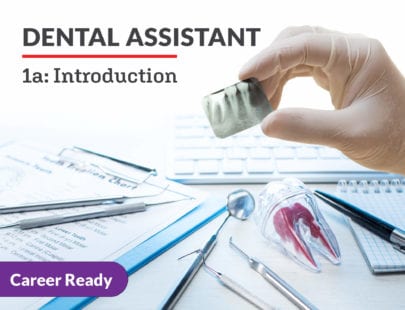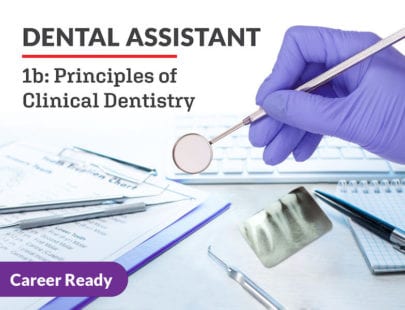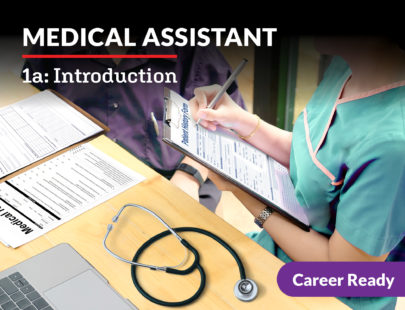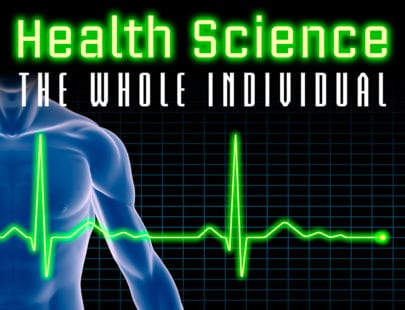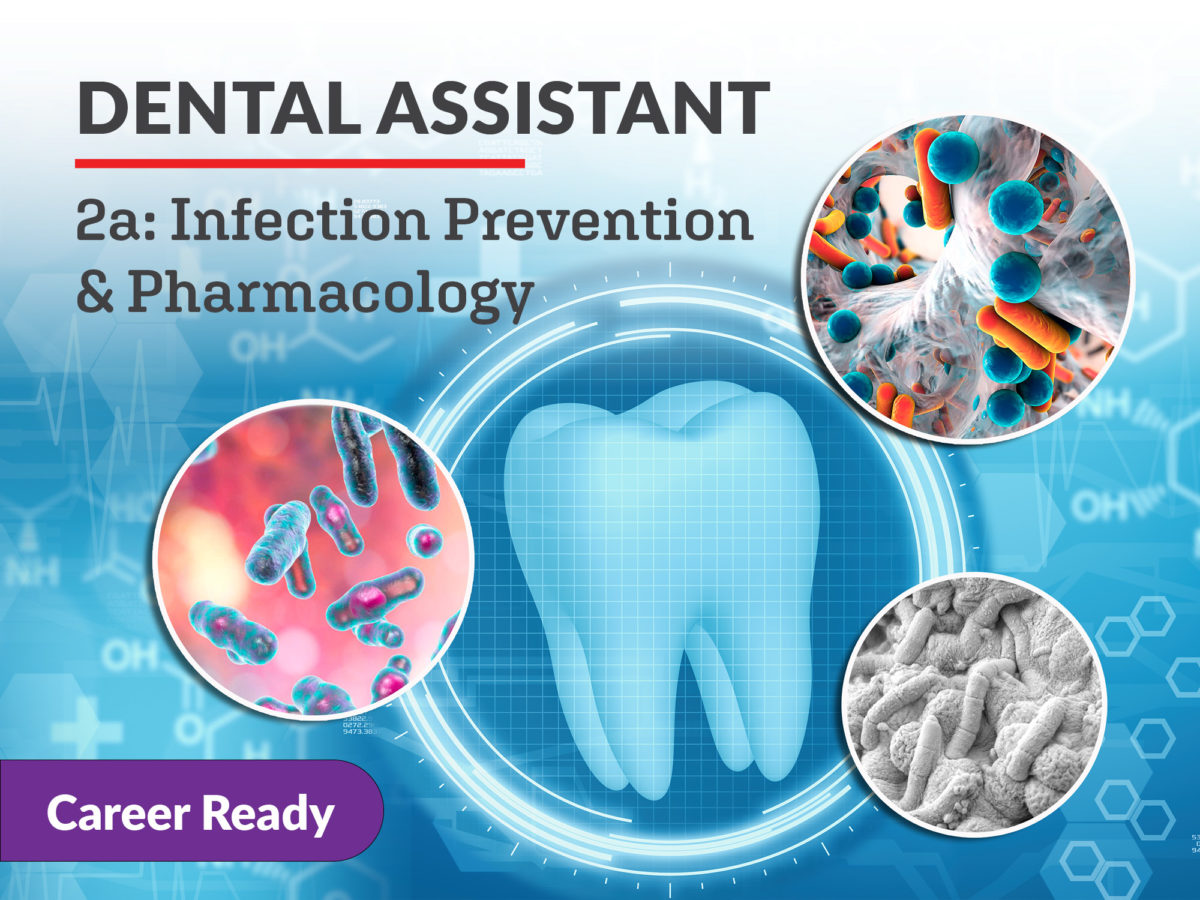
Dental Assistant 2a: Infection Prevention and Pharmacology
Your passion for dentistry has strong roots, and now it’s time to drill even deeper into the pulp of the science. In this course, you will continue to explore the field of dentistry through a work-based learning experience while studying how to maintain a safe environment for patients. You’ll cover prevention, recognition, and management of common dental office emergencies and how to manage patient pain and medications. You’ll learn about microbiology and the modes of disease related to oral care as well as explore specialties in the dental field important responsibilities and guidelines for providers. Let’s continue sharpening your cusp of knowledge as a dental assistant!
Units at a Glance
Unit 1: Medical Emergencies in the Dental Office
A medical emergency can occur at any moment in a dental office. Dental professionals must be trained to understand the signs of a dental emergency and know what actions are indicated. The quick response of dental team members can alter the outcome of a potentially life-threatening event. Proper training, along with relevant updates as necessary, should occur regularly within an office to ensure all team members understand their assigned roles during an emergency situation.
What will you learn in this unit?
- Describe elements of preparing for an emergency and how to successfully manage an emergency in the dental office
- List items commonly found in an emergency kit
- Identify the proper sequence for performing CPR, using an AED, and performing abdominal thrusts
- Discuss common medical emergencies in the dental office and how to respond
- Explain how to respond and treat allergic reactions in the dental office
Unit 2: Microbiology
Understanding microbiology is the foundation of infection control. Part of microbiology is learning about various pathogens and the way they affect the body. When a dental assistant understands how diseases are transmitted, they can properly protect patients against cross-contamination.
What will you learn in this unit?
- Explain the importance of microbiology to a dental assistant
- Identify the major groups of microorganisms
- Discuss bacterial diseases, including the leading cause of death from an infectious disease worldwide
- Describe the symptoms of various viral diseases, including herpes simplex virus 1 and 2
Unit 3: Disease Transmission & Infection Control
Pathogens are all around us and can enter a host at any time. A dental assistant must know how diseases are spread so they can work to prevent cross-contamination. Gloves, masks, and protective clothing are an essential part of protecting employees. Federal, state, and local guidelines must be followed for every procedure, including waste disposal, in order to ensure everyone’s safety.
What will you learn in this unit?
- Name the links in the chain of infection
- Describe the modes of disease transmission
- Discuss the importance of the OSHA BBP Standard
- Explain the role of the CDC in dentistry
- List the types of PPE and other infection control practices
- Give examples of various types of waste found in the dental office
Unit 4: Disinfecting Procedures and Instrument Sterilization
One of the most important roles of a dental assistant is properly following disinfecting and sterilization procedures. Learning the difference between disinfection and sterilization is the first step to taking on that role. Knowing how to load a sterilizer and monitor it for successful sterilization are necessary parts of preventing disease transmission.
What will you learn in this unit?
- Discuss environmental infection control of clinical contact surfaces
- Define disinfection and sterilization
- Describe the ideal instrument processing area
- Identify the three most common methods of heat sterilization and the advantages and disadvantages of each
- Explain sterilization monitoring
Unit 5: Managing Hazardous Chemicals and Waste
Dentistry has many governing agencies that work together to protect dental professionals. Hazardous chemicals and waste can put employees in danger if they are not properly used, stored, or disposed of. Understanding the standards and regulations that apply to dentistry is an essential part of being a dental assistant.
What will you learn in this unit?
- Discuss professional organizations and associations, such as the ADA and ADAA
- Explain how chemicals can enter the human body and methods of protection against exposure to hazardous chemicals
- Describe the components of an Occupational Safety and Health Administration Hazard Communication Program
- Identify the classifications of waste
Unit 6: Principles of Pharmacology
Pharmacology is an important part of dental treatment. In the dental office, a variety of drugs can be used to treat different patient conditions and help address treatment-related anxiety. A dental assistant must be responsible for and have a general understanding of pharmacology to be an effective team member.
What will you learn in this unit?
- Differentiate between a drug’s chemical, generic, and brand name
- Identify parts of a prescription
- Give the routes of administration for drugs
- List the drugs commonly prescribed in dentistry and their uses
Unit 7: Understanding Pain Management Protocols
Dentistry today offers a patient more options for managing pain and anxiety than ever before. This facet of dentistry is continually evolving, and new technology becomes available every year for managing anxiety and pain. The dental assistant plays an important role in preparing anesthetics and monitoring the patient during treatment. As a result, dental assistants must be willing to keep up to date on changes in pain management to help provide a high level of care to their patients.
What will you learn in this unit?
- Compare and contrast topical and local anesthetics
- Discuss local anesthetic injection techniques, including complications
- Explain the set-up for local anesthesia
- List the advantages of using nitrous oxide for dental treatment
- Describe the conditions in which antianxiety drugs, intravenous sedation, and general anesthesia may be used in dentistry
Unit 8: Drug Addiction
As long as there have been drugs, there have been those who misuse or overuse them. The history of drug abuse and addiction can be traced back for centuries. However, as common as drug addiction has been throughout time, America is currently in the midst of a significant opioid epidemic that has impacted millions of families and taken thousands of lives. Knowing about both the past and current state of the crisis is essential in dentistry, as patients are often prescribed opioids to manage their pain after dental procedures, and unfortunately, any initial exposure to opioids can lead to dangerous patterns of addiction. When dental assistants know the signs and symptoms of misuse, abuse, and addiction, they are better equipped to educate their patients and help keep them safe from developing unhealthy relationships with opioids and other drugs.
What will you learn in this unit?
- Define drug addiction
- Identify addiction and its behavioral elements, as defined in DSM 5
- Describe the signs and symptoms of drug abuse.
- Characterize the pharmacology of opioids
- Describe the withdrawal and tapering side effects of opioid use
Required Materials
Physical
- Video recording device
- Various household items
Software
- Word processing software
- Presentation software
Other
- Helper
Optional
- Thumb drive
- Google Drive
- Posterboard
- Art supplies
- Audio recording device
- Digital camera
- Graphic design software
